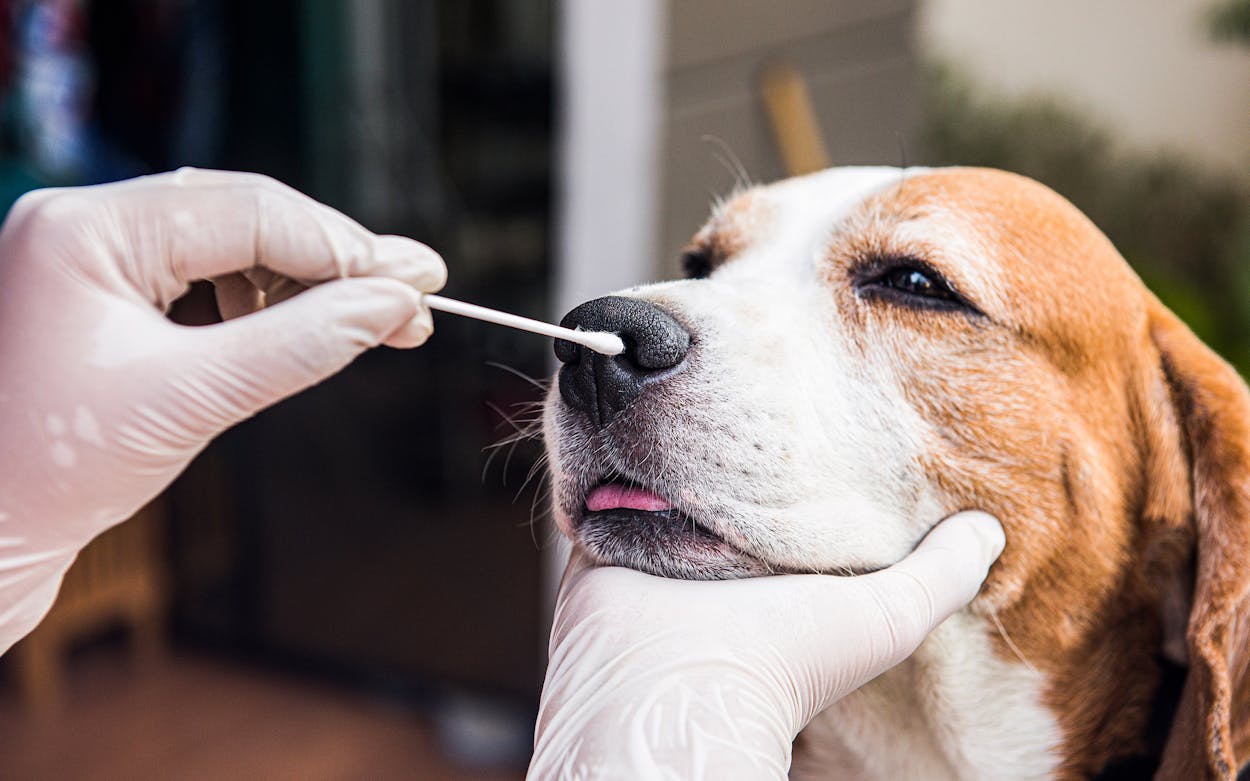Brushing a dog’s teeth is hard enough. The dog looks at you plaintively, eyes wide with betrayal, as you insert the toothbrush and perform a quick pantomime of a tooth cleaning in the seconds before it closes its jaws—and heart—to you.
Researchers at the lab of Texas A&M veterinary epidemiologist Sarah A. Hamer have a more difficult task: they must get pets to submit to a nasal swab, something which even many humans have to be cajoled into doing. Their aim is to better understand how COVID-19 spreads from humans to their pets, and how a pet’s behavior, such as whether it shares an owner’s bed or whether it is a prolific face licker, affects that transmission.
The testing has involved more than six hundred animals—mostly in Central Texas—who live in households where at least one human has COVID. Only about a quarter of the pets from which Hamer’s team has taken samples since June 2020 have tested positive for SARS-CoV-2, the virus that causes COVID, and just one quarter of those infected pets were symptomatic. Some suffered sneezing, diarrhea, runny noses, and irritated eyes, but the most common symptom owners reported was lethargy: their dogs and cats simply seemed lazier than usual.
“It was all very mild illness, and it all sort of resolved without veterinary interventions,” Hamer said. “From our study, we have no evidence that the virus is killing pets.” (She noted, however, that there have been reports of animals with comorbidities experiencing more severe illness, just as humans might.)
Despite this relatively low threat to cats and dogs, the lab’s work is crucial for surveilling, and understanding, the coronavirus—especially because the pandemic is thought to have originated from an animal-to-human transmission event. (Hamer’s team identified the first known UK variant of the coronavirus in an animal, in March 2021.) Casey Barton Behravesh, an A&M grad who’s now an expert on zoonotic diseases with the Centers for Disease Control and Prevention, explained that when viruses jump from species to species, there is an increased risk of mutations creating new variants. The CDC has consequently funded much of Hamer’s research, providing about $225,000.
“It’s important to look at both people and animals, tracking mutations and the possible formation of variants, so we can keep a close eye on what might be happening,” Barton Behravesh said. “We don’t want to see a strain emerge that becomes more serious in terms of illness in people or animals. We don’t want a strain to emerge that can’t be detected by the diagnostic tests that we have available, or that might impact the therapeutics that are becoming available, or impact the vaccine.”
The Hamer Lab recently launched a second, more intensive phase of its research. It’s collecting and testing nasal swabs, oral swabs, and rectal swabs from cats and dogs, as well as samples from pets’ food bowls and water bowls, on three separate occasions. The researchers also take samples from the owners (nonrectal). The unique challenges of testing pets mandate adaptations to the process used for testing humans. The nasal swabs the lab uses, for instance, don’t go very deep into cats’ and dogs’ noses, but they are extra long, so that testers can keep their hands a safe distance from teeth should the proceedings take a melodramatic turn.
The virus is a more salient threat than a bite, though. The lab researchers wear white Tyvek suits, face shields, booties, double gloves, and N95 respirators when they make their house calls. For the sake of neighbors who may be disturbed to see a group in hazmat gear march across their lawns, Hamer’s team members sometimes wait to get suited up until they are at a house’s front door or, if they’re able to test outdoors, until they’re in the backyard.
Like neighbors, cats and dogs are often suspicious of the visitors. Lisa Auckland, a research associate in the College of Veterinary Medicine and Biomedical Sciences at Texas A&M, has been present for nearly every sample-collecting expedition Hamer’s team has conducted. “Because we look like we look, they’re usually really anxious with us. They don’t know what to make of us, because we look so weird,” she said. “We just try to use our pet-speaking voices.”
To placate jittery pets, team members let the animals sniff their hands and suits. And if pets are more comfortable being tested while sitting in their owners’ laps, there they shall stay. In the case of cats—especially indoor cats prone to zoomies and hiding—the lab recommends that owners contain their pets in a confined space, such as a laundry room or bathroom, before the testers arrive.
Many pet owners volunteer for the study out of curiosity (quite a few have been research-minded types from the university community). Others are just eager to do anything they can for their pets—especially during a pandemic. “We’re not offering a treatment for COVID-19 in pets,” Hamer clarified. “This is just surveillance. But people just want to contribute to the greater good.”
The A&M researchers and the CDC recommend that pet owners who have tested positive for COVID-19 wear masks around, and isolate from, their pets—and from any other animals—to prevent passing the virus on. But this advice has met with resistance from some owners. Hamer understands why. “It’s just so hard to cut yourself off from your pet,” she said. “Especially if you’re not feeling well. You want to be in bed with your pet, snuggling.”
Early on in the pandemic, the lab sourced cases through the Brazos County Health Department: people who tested positive were asked whether they had a pet and whether they were interested in participating in Texas A&M research. If they answered yes to both, Hamer’s lab received their contact information. Especially during the socially isolated shutdowns of the pandemic’s first several months, many volunteers were thrilled to be among strangers, even strangers in space suits. “All they wanted to do was talk,” Auckland recalled, “and we were glad to listen.”
Toward the end of the first phase of Hamer’s research, in the summer of 2020, COVID-19 cases dropped, falling from a peak of around 10,400 cases a day in mid-July to about 3,200 cases per day two months later. Enrollment in the pet study followed suit. Auckland hypothesized that many potential participants were simply “over” COVID: even if they were still getting sick, they weren’t interested in giving their time to science. Now that the threat of the highly infectious omicron variant has subsided in Texas, new subjects have petered out again. (Pet owners who test positive for COVID-19 can opt in to the study here.)
Hamer’s research differs from other work with animals in part because her lab is not just testing animals that have been brought to a vet clinic because they are showing symptoms; the team is seeking animals living in high-risk environments to see whether they are sick or not. Because of that, the researchers can detect cases that might otherwise go unnoticed. (That, plus the hustle of Hamer and her team, may be one reason Texas disproportionately leads the the U.S. Department of Agriculture’s overview of confirmed cases of SARS-CoV-2 in animals in the United States, with 107 cases compared to 24 in the next-highest state, California.)
Barton Behravesh said COVID-19 has been seen on mink farms in Europe and the United States, and in wildlife in North America, but the animals often “appear to be perfectly happy, and you wouldn’t know it.” Without surveillance testing, COVID-19 could slyly move from animal to animal, even between species, eventually evolving and mutating into something more concerning.
Hamer is seeking funding to expand the lab’s work beyond cats, dogs, and other household pets to include potential wildlife reservoirs of COVID-19, such as white-tailed deer, whose viral receptors are similar to those of humans. A prior study by the Hamer Lab showed 34 of 36 white-tailed deer in one Texas facility had COVID-19 antibodies, suggesting animal-to-animal transmission rather than transmission due to human-to-deer contact. (A team of researchers in Canada recently reported that a white-tailed deer in Ontario may have passed COVID-19 to a human who was in close contact with the animal.)
For now, though, the risk of pet-to-human transmission of COVID-19 appears to be very low. Healthy pet owners may hold their cuddly nonvectors tight.
- More About:
- Health
- Pandemic
- College Station








